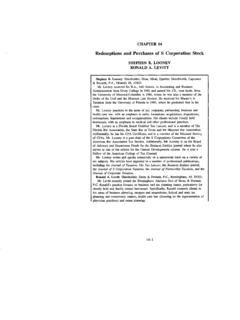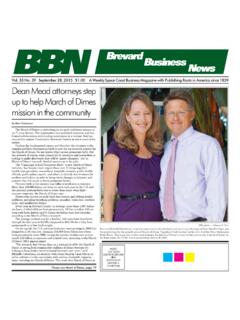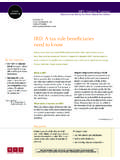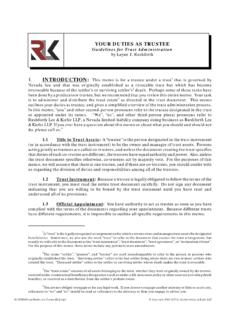Transcription of TRUSTEES BEWARE: Understanding Your Trustee …
1 Dean, Mead, Egerton, Bloodworth, Capouano & Bozarth, 800 North Magnolia Avenue, Suite 1500 Box 2346 (ZIP 32802-2346) Orlando, FL 32803 Orlando Fort Pierce Viera 407-841-1200 407-423-1831 Fax LAUREN Y. DETZEL 407-428-5114 September 2009 TRUSTEES beware : Understanding your Trustee Duties and How to Stay Out of Trouble Lauren Y. Detzel, Esq. September 2009 I. Introduction TRUSTEES have numerous responsibilities in the administration of a trust. There are many situations where a Trustee can trip up and unknowingly expose itself to liability. This outline will discuss common issues that arise in the administration of a trust and the proper way a Trustee can address these problems while limiting its potential liability. The Top Issues that Get TRUSTEES in Trouble: 1. Investment Issues a. Trust owns non-income producing property or underperforming assets. b. Trust assets are not diversified. c. Inappropriate investments for purpose of trust.
2 D. Too risky / Too safe. 2. Irrevocable Life Insurance Trusts 3. Payment of Fees a. Trustee fees. b. Excessive professional fees. 4. Conflicts of Interest a. Trustee is also an owner of an entity in which the trust also owns an interest. b. Trustee is also a beneficiary of the trust. 5. Discretionary Distribution Standards Exercise of a Trustee s discretion in making distributions to beneficiaries is always a potential liability. Distributing too much or too little, showing preference to one beneficiary over another, let us count the ways to get into trouble here! 6. Keeping the beneficiaries Informed TRUSTEES have specific requirements for informing the trust beneficiaries during the administration. Properly doing so greatly limits a Trustee s potential liability. 7. Tax Issues Trusts may have certain assets or tax attributes which require special care by the Trustee . If the Trustee does not properly address these issues, or worse yet, does not even know the issues exist, the Trustee could harm the trust and the beneficiaries , leaving itself exposed to liability.
3 TRUSTEES can inadvertently cause a corporation to lose a subchapter S election, incur generation skipping transfer tax, fail to make a 754 election, or accelerate income tax to the income beneficiary to name a few ways. 8. Ending the Trust Administration TRUSTEES need to exit as Trustee without incurring further liability, especially considering that the Trustee will no longer have the trust funds to look to for the payment of litigation expenses. 9. Trust Litigation Knowing the standards that a court will hold the Trustee to can help TRUSTEES make better decisions in administering the trust. II. Investment Issues A. Examples of Investment Issues The following are classic examples of problems that occur regarding investments of trust assets: 1. Surviving Spouse is income beneficiary and children of a prior marriage are remainder beneficiaries of a trust. Spouse wants the trust invested to produce maximum income and children want the trust to concentrate on growth investments.
4 Does it matter if the Trustee has the power to invade principal for the spouse s benefit? Consider electing the trust to be treated as a unitrust. 2. Decedent died owning a large percentage of his assets in real estate, some income producing but others are a large cash drain. The market value has decreased. What does the Trustee do? 3. Decedent s spouse and/or child want the family s longtime investment manager to make the investment decisions but you don t really feel comfortable with the manager s investment policies or plans. 4. Decedent died owning a closely held business which is now in a trust for the benefit of children who can t agree about how the business should be run or sold. 5. The assets in the trust portfolio have declined in value and there is a very uncertain economic climate. Does the Trustee sell assets, hold cash and wait? What if the market rebounds and the Trustee doesn t get to participate in any of the profits while the Trustee is sitting out ?
5 6. See the case of Parker v. Shullman, 983 643, (Fla. 4th DCA 2008). beneficiaries complained of decline in value of trust assets due to the Trustee s investment decisions. The Trustee was not held liable because the Trustee s actions were reasonable at the time and the Trustee relied on professional investment advice. How does the Trustee deal with these issues? B. Avoiding Liability by Following the Appropriate Standard of Care 1. A Trustee has a duty to invest the trust assets as a prudent investor would. The prudent investor rule is a test of conduct and not of performance. The standard is applied not to investments in isolation, but in the context of the investment portfolio as a whole and as a part of an overall investment strategy incorporating risk and return objectives reasonably suitable for the trust. (1)(a). a. No single investment decision is viewed in isolation. The court will look at all circumstances surrounding the investment decisions at the time the investment was made.
6 (1)(b). b. Duty to diversify. (1)(c). Can be a problem with real estate or closely held business assets. c. Duty to review existing investments of the trust within a reasonable time after acceptance of the trust. (1)(d). C. Investment Plan 1. In implementing the investment plan, the Trustee should document the factors considered in determining a reasonable investment portfolio. a. General economic conditions. b. Possible effect of inflation. c. Expected tax consequences of decisions or strategies. d. Role of each investment within the portfolio. e. Expected total returns. f. Costs. g. Purposes, terms, distribution requirements and other circumstances of the trust. 2. In carrying out the investment plan, the Trustee should review the investment portfolio at least annually, or more frequently in times of market fluctuations, and document the reasons for maintaining or changing the portfolio.
7 3. The duty of a Trustee to diversify investments is routinely modified, or even waived, under the terms of many trusts. Trusts often provide that a Trustee may retain assets contributed to the trust, regardless of the risk of the contributed asset or the resulting lack of diversification. D. Reliance on the Terms of the Trust 1. If the trust document specifically authorizes certain investments, the Trustee can reasonably rely on the terms of the trust. (2); 2. If the terms of the trust regarding the trust investments no longer seem reasonable, the Trustee can obtain a court order to deviate from the terms of the trust. (3)(a). E. Court Approval (3)(b) specifically authorizes a Trustee to obtain court approval for any action regarding trust investments. F. Beneficiary s Consent A Trustee is not liable to a beneficiary for a breach of trust if the Trustee has fully disclosed his proposed actions and beneficiary has willingly consented to them.
8 The consent must not be improperly induced and the beneficiary must know of the beneficiary s rights. If a Trustee is concerned about the trust investment or an underperforming asset held by the trust, he can obtain consents from the beneficiaries to relieve him from personal liability. In order for a consent to be valid, however, the Trustee must fully disclose all of the facts surrounding the transaction. G. Reliance on Investment Advice The court in Parker v. Shullman held that the Trustee was not liable for a decline in the trust assets because the Trustee took careful steps to interview investment advisors, schedule meetings with the advisors on his duties as Trustee , and followed the advice of the advisors. H. Delegating Investment Decisions A Trustee may delegate duties and powers, including investment decisions, that a prudent Trustee of comparable skill could delegate under the circumstances, provided the Trustee exercises reasonable care in selecting the agent, defining the scope of the delegation and monitoring the agent s performance.
9 If the investment functions are properly delegated to an agent, the Trustee will not be held liable for any investment decisions by the agent. (4). To properly delegate the TRUSTEES investment functions, the Trustee must: 1. exercise reasonable care in selecting the agent, establishing the scope and terms of the delegation and periodically reviewing the agent s actions. (1); and 2. give notice of the intent to delegate the investment functions to all beneficiaries who are entitled to receive distributions from the trust. (3). In performing the delegated functions, the agent is subject to the same fiduciary standards for the trust investments. (6). I. Statute of Limitations The statute of limitations is discussed in Section VII, below. III. Irrevocable Life Insurance Trusts ( ILITs ) A. ILITs Present Unique Issues for TRUSTEES 1. Continued suitability of policy. a. Financial viability of insurer.
10 B. Comparative cost of newer policies. 2. Additional notice requirements. a. Crummey withdrawal notices. b. Actions in respect to policies. 3. Payment of premiums when the trust has no, or few, other assets. B. Prudent Investor Rule 1. Trustee has a duty to invest and manage investment assets as a prudent investor would considering the purposes, terms, distribution requirements, and other circumstances of the trust. See Section II, above. The Trustee must consider: a. Whether an insurance policy is or remains a proper investment. b. Whether to exercise a policy option. c. Whether to diversify insurance policies relative to one another or to other assets, if any.










